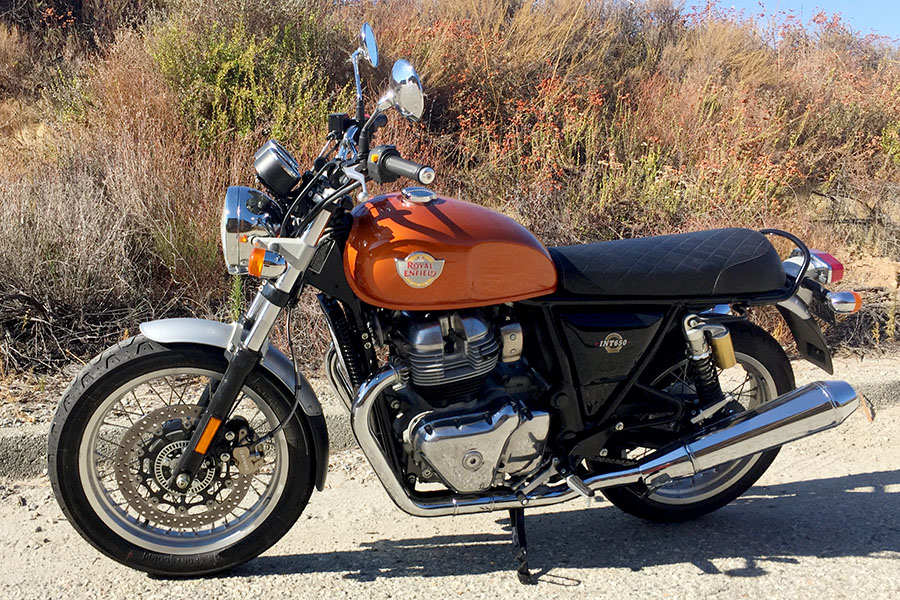I think most motorcycle videos are silly, including the ones I’ve done (and I’ve done a few). It’s a personal preference…videos (compared to the written word and good photography) dumb down whatever they cover, and I would much rather read a good article with great photos than watch a video. But on occasion I’ll stumble across a video I enjoy. I recently encountered a couple that hit home for me. One compares the Royal Enfield 650 to the Kawasaki W800, and the other compares the Enfield to a Triumph Bonneville.
Back in the day (the 1960s), British vertical twins ruled the roost, and of those the Triumph Bonneville was the king. My father rode a 1966 Triumph Bonneville, and I’ve owned a number of Triumphs from the ’60s and ’70s. They were (and still are) awesome motorcycles. It just makes sense to me that ’60s-era British vertical twins are a platform deserving of the sincerest form of flattery (i.e., copying), and apparently, the modern incarnations from Kawasaki, Royal Enfield, and Triumph do exactly that. Well, maybe not exactly, but enough to let you imagine you’re Steve McQueen.
These videos are fun to watch. The narrators are funny as hell and there are some great quotes. One was, “I’m not even going to try to keep up with you on the way back…you just take care of yourself and watch out for buffalo.” That quote reminded me of Gresh’s video when he entered a corner a bit too hot on a Harley Sportster and famously said, “It handles pretty well when it’s out of control.”
The video editing and imaging in these two videos are superior (way better, in my opinion, than what you see from the self-proclaimed videomeisters here in the US). And the tech content is light years ahead of the typical vlogger tripe clogging up our bandwidth.
Enjoy, my friends.
Here’s a fun fact: All three of these bikes (the Royal Enfield Interceptor, the Kawasaki W800, and the Triumph Bonneville) purport to copy British vertical twins, yet none of these bikes are British. The Enfield is made in India, the Kawasaki is made in Japan, and the Triumph is made in Thailand.
I ride a Royal Enfield 650. I like my Enfield, and for the money, the Enfield has to be one of the best buys ever in motorcycling. Gresh and I already did a road test of the Enfield in Baja, and you can read our reports on it here. One of these days in the near future I’ll do a road test my current Enfield and tell you what it’s like to own one of these grand machines, but I’ve got another road test I’m going to post first. That’s on the 250cc CSC RX3, 5 years in. Good buddy Sergeant Zuo over in Lanzhou has 50,000 miles on his RX3 and it’s still going strong.
I am enjoying my Enfield, and I just found a bunch of Enfield accessories available online through Amazon. I’ll poke around on there a bit later today.
Stay tuned, folks. More good stuff is coming your way.
Sign up for your free ExNotes subscription!


 Kawasaki’s bold new W800 Café looks a lot like a restyled W800 standard but we here at Wild Conjecture have no way of confirming this statement. You see, Wild Conjecture by its very name is nothing but guesses bulked up with opinion into a plausible hunch.
Kawasaki’s bold new W800 Café looks a lot like a restyled W800 standard but we here at Wild Conjecture have no way of confirming this statement. You see, Wild Conjecture by its very name is nothing but guesses bulked up with opinion into a plausible hunch.
 Kawasaki claims the styling is inspired by Kawasaki’s W1 650, which taken to its logical conclusion would mean the Café was inspired by an ancient 1950’s BSA A7 (later becoming the A10) twin. And that’s not a bad thing. For years the W1 650 held the title of the largest displacement motorcycle built in Japan until the CB750 Honda came sauntering into the room.
Kawasaki claims the styling is inspired by Kawasaki’s W1 650, which taken to its logical conclusion would mean the Café was inspired by an ancient 1950’s BSA A7 (later becoming the A10) twin. And that’s not a bad thing. For years the W1 650 held the title of the largest displacement motorcycle built in Japan until the CB750 Honda came sauntering into the room. For me, the Café looks good overall but misses the mark in a few key areas. The colors shown on Kawasaki’s web site are dreadful. The faring and side covers are a mismatch for the fenders and gas tank. I know this is done on purpose but a bike like this should have an all alloy tank with chrome fenders. Kudos to Kawasaki for trying something different. Better luck next time.
For me, the Café looks good overall but misses the mark in a few key areas. The colors shown on Kawasaki’s web site are dreadful. The faring and side covers are a mismatch for the fenders and gas tank. I know this is done on purpose but a bike like this should have an all alloy tank with chrome fenders. Kudos to Kawasaki for trying something different. Better luck next time. The forks, side covers, rear fender and exhaust all look great to me. I like the shaft-driven camshaft and the air-cooling system. Hopefully you’ll be able to buy the thing without anti-lock brakes but I suspect the days of ABS delete are nearly over.
The forks, side covers, rear fender and exhaust all look great to me. I like the shaft-driven camshaft and the air-cooling system. Hopefully you’ll be able to buy the thing without anti-lock brakes but I suspect the days of ABS delete are nearly over.